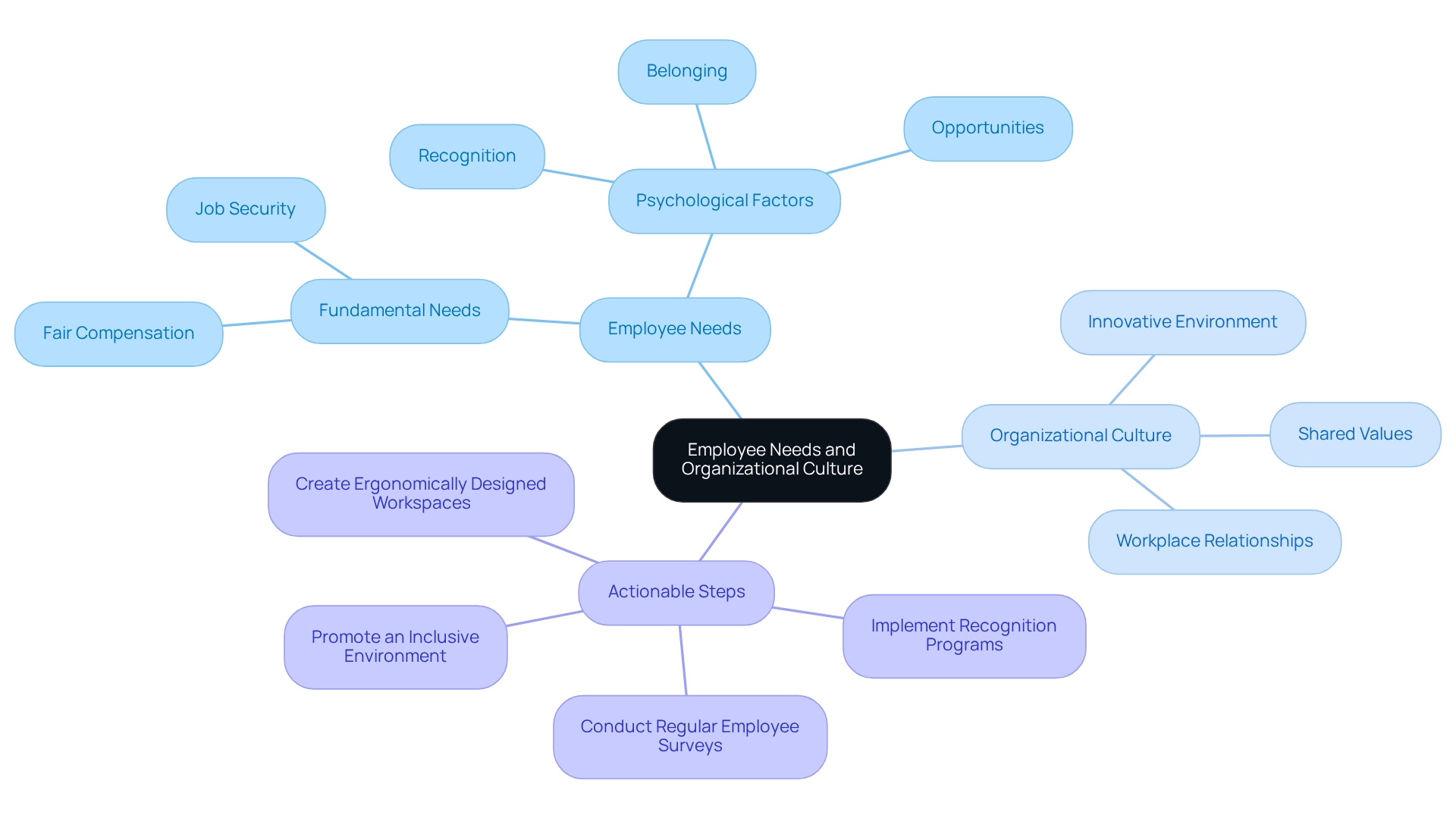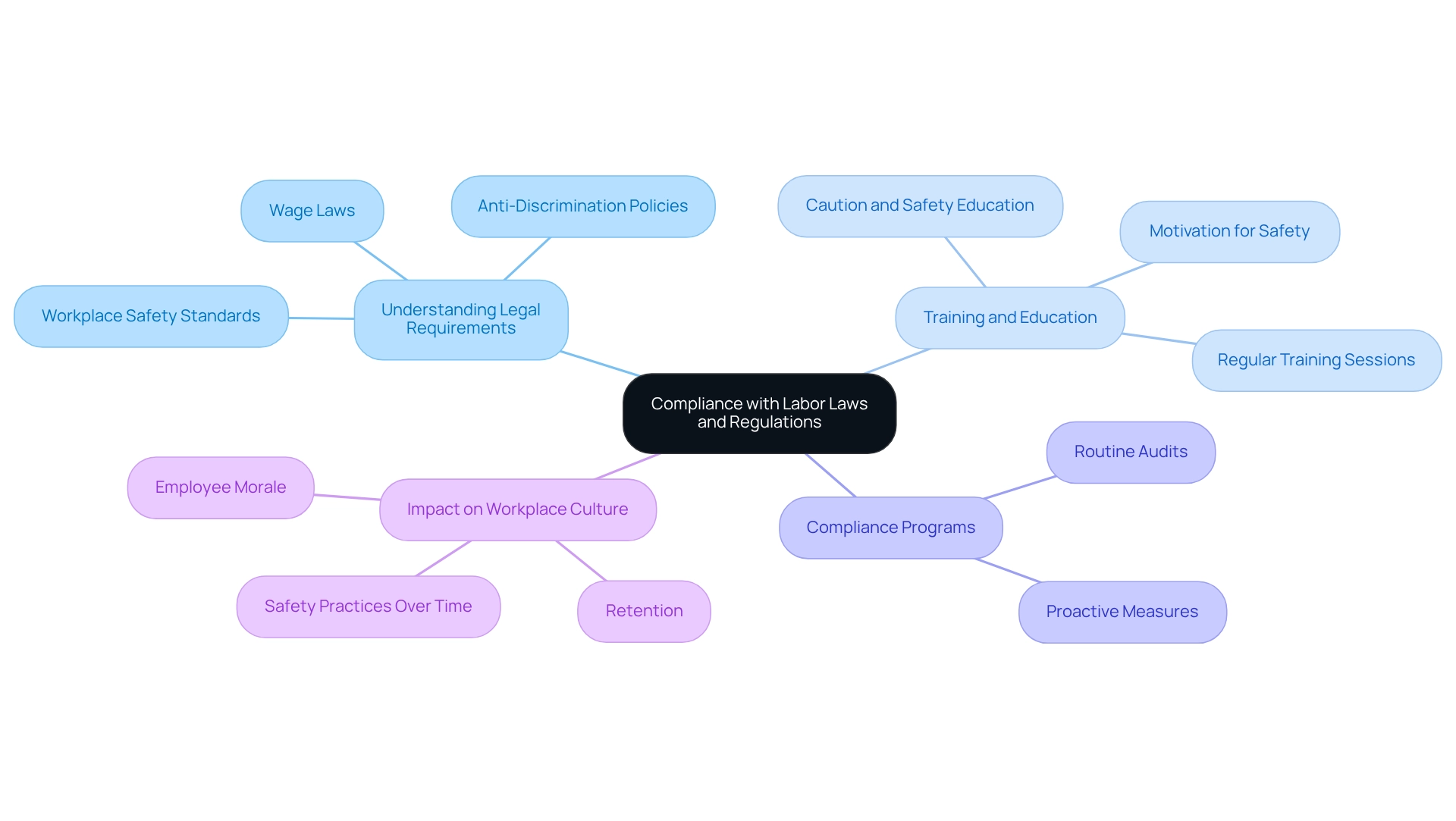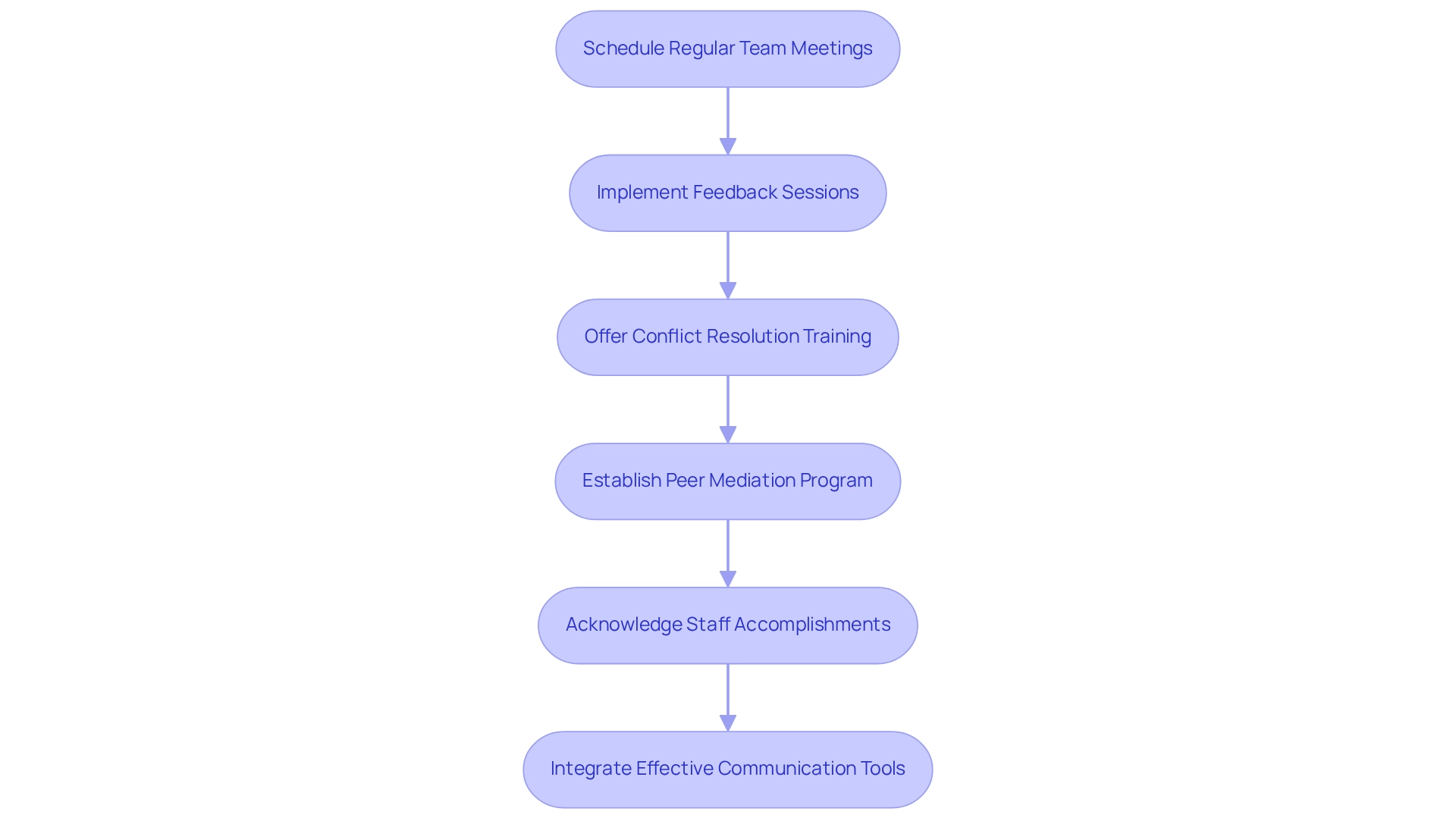Overview
To enhance job satisfaction, organizations must comprehend employee needs—including fair compensation, recognition, and a sense of belonging—and align these with their organizational culture. This alignment is crucial. Regular feedback, positive workplace relationships, and strict compliance with labor laws are essential for fostering a supportive environment that significantly improves employee morale and retention.
Key Highlights:
- Understanding employee needs, including fair compensation and psychological factors, is crucial for improving job satisfaction.
- Regular surveys and feedback sessions help organizations gauge employee sentiments and adapt to job market dynamics.
- Aligning employee needs with organizational culture enhances belonging and purpose in roles.
- Positive workplace relationships significantly contribute to job satisfaction, with recognition playing a key role.
- Compliance with labor laws and regulations protects worker rights and enhances organizational reputation.
- Regular training and audits are essential for maintaining compliance and improving workplace safety.
- Effective talent acquisition requires clear job descriptions, competitive compensation, and a positive candidate experience.
- Transparent salary ranges attract younger talent and foster a culture of openness.
- Robust onboarding and mentorship programs improve retention rates and employee loyalty.
- Open communication and conflict resolution training are vital for fostering positive employee relations.
- Integrating effective communication tools enhances internal communication, especially in remote work settings.
Introduction
In the contemporary workplace, understanding and addressing employee needs has become paramount for organizational success. As companies navigate the complexities of job satisfaction, compliance with labor laws, effective talent acquisition, and fostering positive relations, the stakes are higher than ever.
Statistics reveal significant gaps in employee satisfaction and engagement—are organizations truly prioritizing a culture that values recognition, open communication, and inclusivity?
This article delves into critical strategies that can enhance job satisfaction, ensure compliance, attract top talent, and cultivate a harmonious work environment. Ultimately, these efforts lead to a more engaged and productive workforce. The time for action is now.
Understand Employee Needs and Organizational Culture
To effectively enhance the perception of job satisfaction, companies must prioritize understanding the diverse requirements of their employees. This encompasses not only fundamental needs such as fair compensation and job security but also psychological factors like recognition, belonging, and opportunities that contribute to overall job well-being. Regular surveys and feedback sessions serve as essential tools for gauging employee sentiments and expectations, enabling organizations to adapt to the evolving dynamics of the job market.
Aligning these requirements with the organizational culture—characterized by shared values, beliefs, and behaviors—ensures that individuals experience a sense of belonging and purpose in their roles. For instance, a company that champions innovation should actively solicit creative suggestions from its employees, cultivating an environment where their contributions are genuinely valued. This alignment is critical; research indicates that only 18% of employees report being extremely satisfied with their organization, underscoring the urgent need for organizations to adapt to shifting job market dynamics. Furthermore, 84% of employees assert that a comfortable, ergonomically designed workplace directly influences their satisfaction, while teams with more than two members expressing job dissatisfaction experience a staggering 40% decline in collaborative effectiveness.
Moreover, robust workplace relationships play a significant role in enhancing job satisfaction. A recent survey reveals that positive interactions with colleagues and supervisors are pivotal factors contributing to job satisfaction. The case study titled “Work Relationships and Job Satisfaction” highlights that strong workplace relationships positively impact job satisfaction, emphasizing the importance of team dynamics in organizational success. Additionally, it is noteworthy that 28% of employees have never received acknowledgment from their company’s executive team, further emphasizing the critical role of recognition in fostering job satisfaction.
By focusing on these elements, organizations can bolster employee morale and productivity, ultimately leading to increased retention rates and a more engaged workforce. Here are some actionable steps organizations can take to understand employee needs and align them with their culture:
- Conduct regular employee surveys to gather feedback on job satisfaction and workplace dynamics.
- Promote an inclusive environment that values contributions from employees and encourages open communication.
- Implement recognition programs to celebrate employee achievements and efforts.
- Create comfortable and ergonomically designed workspaces to enhance overall worker satisfaction.
Understanding and addressing employee needs while fostering a supportive organizational culture is not just beneficial—it is essential for sustained success.
Ensure Compliance with Labor Laws and Regulations
Organizations must remain vigilant regarding current labor laws and regulations to ensure compliance and protect worker rights. This necessitates a comprehensive understanding of wage laws, workplace safety standards, and anti-discrimination policies. Regular training sessions for HR personnel and management are essential to keep all stakeholders informed about legal requirements. Implementing a comprehensive compliance program, which includes routine audits and assessments, can effectively identify potential gaps in adherence.
Consider this: companies that actively review their hiring practices to align with equal opportunity laws not only mitigate legal risks but also enhance their reputation as equitable employers. Such proactive measures can significantly boost staff morale and retention, as workers feel secure in their rights and valued in their roles. Statistics indicate that organizations prioritizing compliance training experience a marked improvement in workplace safety and staff satisfaction, reinforcing the notion that a commitment to legal adherence fosters a positive organizational culture.
As Walter Dill Scott aptly noted, “The future of the safety movement is not so much dependent upon the invention of safety devices as on the improvement of methods of educating people to the ideal of caution and safety.” This underscores the critical role of education in cultivating a culture of safety. Moreover, Mark French’s case study on motivation and safety behaviors reveals that encouraging staff to prioritize safety is vital for fostering safe practices. Without motivation, employees may not engage in safe behaviors, potentially leading to increased risks. Benjamin Franklin’s lesson that “an ounce of prevention is worth a pound of cure” remains relevant today, emphasizing the value of proactive compliance measures. Furthermore, the statement, ‘Working safely gets old, but so do those who practice it,’ highlights the significance of upholding safety practices over time, underscoring the necessity for ongoing enhancement in workplace safety standards.
Implement Effective Talent Acquisition and Retention Strategies
To ensure a job’s effective attraction and retention of high-quality talent, companies must implement a comprehensive talent acquisition strategy that emphasizes clear job descriptions, competitive compensation packages, and an exceptional candidate experience. As Steve Jobs famously stated, hiring smart people is crucial for driving growth and innovation, underscoring the strategic importance of recruitment in achieving organizational success. At Boutique Recruiting, we specialize in tailored recruitment solutions for high-demand finance and technology roles, ensuring that our approach meets the unique needs of both candidates and employers.
Leveraging technology, such as applicant tracking systems and AI-driven recruitment tools, can streamline the hiring process and significantly enhance candidate engagement. Customized recruitment strategies are vital in navigating the talent war, as they enable companies to connect with top candidates effectively.
Consider this: companies that transparently share salary ranges in job postings have successfully attracted younger talent, including Millennials and Gen Z, who prioritize transparency and fairness in compensation. This approach not only aligns with the expectations of these demographics but also fosters a culture of openness.
Moreover, robust onboarding programs play a crucial role in integrating new hires into the company culture, leading to improved retention rates. Organizations that provide mentorship programs and ongoing professional development opportunities demonstrate a commitment to staff growth, fostering higher job satisfaction and loyalty. In fact, companies with effective onboarding processes report retention rates that are 82% higher than those with less structured approaches.
Consistently evaluating staff satisfaction through surveys offers important insights into areas for enhancement, ensuring that companies remain attentive to workforce needs. As highlighted in the case study ‘Challenges in Recruitment,’ the recruitment landscape is swiftly changing, and companies must adapt to overcome hurdles in talent acquisition. Adopting effective talent acquisition strategies in 2025 will be essential for maintaining a competitive edge in attracting and retaining top talent. Additionally, emphasizing benefits such as healthcare, retirement plans, and unique perks can further distinguish job roles and appeal to prospective candidates.
Foster Positive Employee Relations and Conflict Resolution
To foster positive staff relations, organizations must prioritize open communication and transparency. Regular team gatherings, feedback sessions, and conflict resolution training equip staff with the skills necessary to address issues constructively. A culture of respect and inclusivity can help mitigate conflicts before they escalate. For instance, introducing a peer mediation initiative allows staff members to settle conflicts harmoniously, promoting a sense of community and teamwork. Additionally, acknowledging and celebrating the accomplishments of staff enhances relationships and elevates morale. By creating an environment where staff members feel acknowledged and appreciated, organizations can significantly lower turnover and enhance the perception of the job.
Statistics reveal that 26% of companies utilize online chat tools for internal communication, highlighting the growing importance of effective communication strategies in modern workplaces. This statistic underscores the necessity for financial companies to adopt enhanced communication tools to promote better interactions among staff. Furthermore, with the growth of remote work, 82% of knowledge workers and 90% of business leaders have indicated a heightened demand to enhance their communication skills. This shift emphasizes the need for organizations to invest in conflict resolution training, which has been shown to positively influence workplace relations. As noted, “Once a business understands the need for internal corporate communications best practices and actually implements them, it usually correlates with a motivated workforce and, ultimately, a better bottom line.”
To tackle the challenges of remote communication, companies should consider integrating platforms like Sociabble with tools such as Microsoft Teams to improve information sharing among staff, regardless of their work location. By fostering an atmosphere of open dialogue and providing training programs, companies can enhance staff engagement and drive better outcomes.
Actionable Steps for Implementation:
- Schedule regular team meetings to encourage open dialogue.
- Implement feedback sessions to gather staff insights.
- Offer conflict resolution training to equip staff with necessary skills.
- Establish a peer mediation program to facilitate amicable dispute resolution.
- Acknowledge and celebrate staff accomplishments to enhance morale.
- Integrate effective communication tools like Sociabble with existing platforms to improve internal communication.
By following these steps, organizations can create a supportive environment that fosters positive employee relations and enhances overall workplace efficiency, ensuring the job’s well.
Conclusion
Enhancing job satisfaction and fostering a positive workplace culture are crucial for organizational success. By understanding employee needs, companies can create an environment that prioritizes recognition, open communication, and inclusivity. Regular feedback mechanisms, ergonomic workspaces, and strong workplace relationships play a significant role in boosting morale and productivity. With only 18% of employees reporting extreme satisfaction, it is evident that organizations must take decisive steps to align their cultures with the expectations of their workforce.
Compliance with labor laws is another vital aspect that organizations cannot overlook. By staying informed and conducting regular training, employers can ensure that they are safeguarding employee rights while fostering a culture of safety and respect. Proactive compliance not only mitigates legal risks but also enhances employee morale, creating a more secure and satisfied workforce.
In the competitive landscape of talent acquisition, implementing effective recruitment strategies is essential. Clear job descriptions, transparent compensation practices, and robust onboarding processes can significantly improve retention rates and job satisfaction. Organizations that prioritize mentorship and continuous professional development demonstrate their commitment to employee growth, further solidifying their place as desirable employers.
Finally, fostering positive employee relations through open communication and conflict resolution training can lead to a more harmonious work environment. By empowering employees and celebrating their achievements, companies can cultivate a culture of respect and collaboration. As workplaces continue to evolve, the commitment to understanding employee needs and enhancing workplace dynamics will be paramount for sustained success and engagement. The time for action is now—organizations must prioritize these strategies to thrive in the modern workplace.
Frequently Asked Questions
What factors contribute to job satisfaction according to the article?
Job satisfaction is influenced by fundamental needs such as fair compensation and job security, as well as psychological factors like recognition, belonging, and opportunities for overall job well-being.
How can companies gauge employee sentiments and expectations?
Companies can use regular surveys and feedback sessions to assess employee sentiments and expectations, allowing them to adapt to the evolving dynamics of the job market.
Why is aligning employee needs with organizational culture important?
Aligning employee needs with organizational culture ensures individuals feel a sense of belonging and purpose in their roles, which is critical for job satisfaction.
What percentage of employees report being extremely satisfied with their organization?
Only 18% of employees report being extremely satisfied with their organization.
How does workplace design influence employee satisfaction?
84% of employees believe that a comfortable, ergonomically designed workplace directly impacts their satisfaction.
What effect does job dissatisfaction among team members have on collaboration?
Teams with more than two members expressing job dissatisfaction experience a 40% decline in collaborative effectiveness.
What role do workplace relationships play in job satisfaction?
Positive interactions with colleagues and supervisors are pivotal in contributing to job satisfaction, emphasizing the importance of strong workplace relationships.
How many employees have never received acknowledgment from their company’s executive team?
28% of employees have never received acknowledgment from their company’s executive team.
What are some actionable steps organizations can take to improve job satisfaction?
Organizations can conduct regular employee surveys, promote an inclusive environment, implement recognition programs, and create comfortable workspaces to enhance job satisfaction.
Why is understanding and addressing employee needs essential for organizations?
Understanding and addressing employee needs is essential for sustained success as it bolsters employee morale and productivity, leading to increased retention rates and a more engaged workforce.






